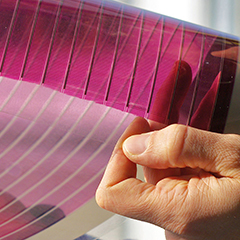In the field of organic photovoltaics, researchers are working hard to further increase the solar cell efficiency. New materials obtained from synthetic organic chemistry have enabled significant efficiency increases in recent years. Maintaining the efficiencies achieved in the laboratory on tiny solar cells is often a challenge when the cell area becomes larger. Now Fraunhofer ISE together with the Freiburg Materials Research Center FMF of the University of Freiburg has achieved a record efficiency of 14.9% for organic solar cells with an area of at least 1 cm². This marks an important step for this cost-effective technology on its way to application maturity.
The Fraunhofer Institute for Solar Energy Systems ISE has been working on organic solar cells and modules in close cooperation with the Freiburg Materials Research Center FMF of the University of Freiburg for many years with the aim of further developing this technology together with industry partners and making it available at low cost. The principle research focus is to use cost-effective and environmentally friendly materials as well as to develop upscaling methods using roll-to-roll processes enabling solar modules to be produced in a similar manner as films.
Organic photovoltaics has special properties that enable numerous new fields of application. Organic solar cells can be produced without using heavy metals and other problematic elements. They are lightweight, mechanically flexible and can be easily integrated giving a homogeneous appearance even in semi-transparent designs. By selecting organic semiconductors that only absorb infrared light, transparent solar cells for windows, protective foils for agriculture or greenhouse films and glazings can be developed. These combine several benefits such as storm protection and overheating while providing power generation at the same time. Since organic solar modules can be produced with low material and energy use, they offer a high potential for CO2 savings, which can become even greater when considering the synergetic uses. Organic photovoltaics can aid in preventing and adapting to climate change: when installed on protective foils in agriculture the generated electricity yield can help finance the system. Before such products are ready for market, however, there are still important development steps to be made.






























